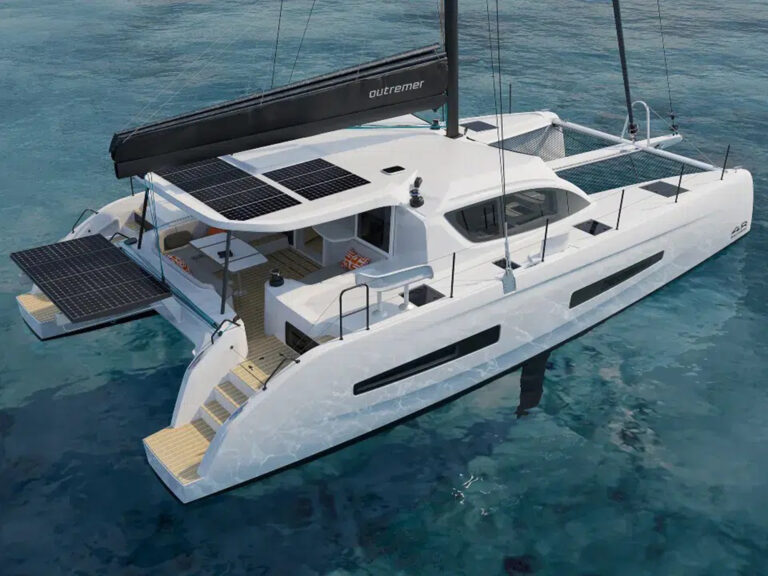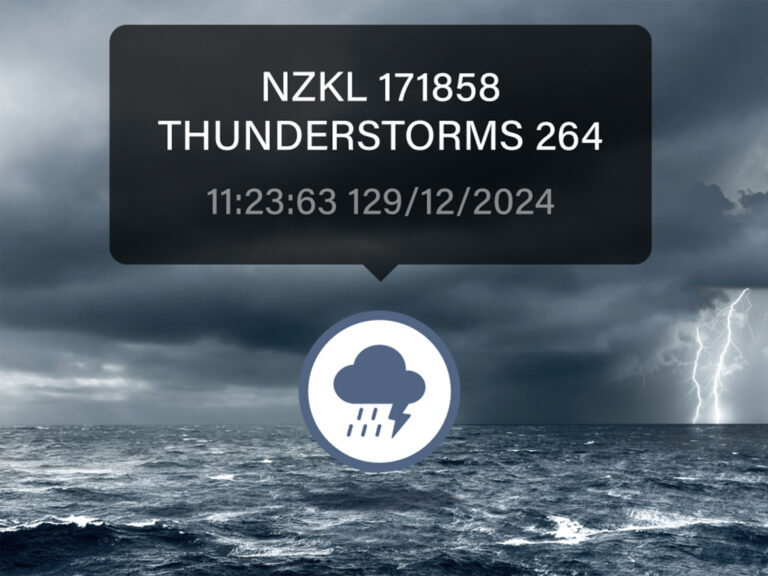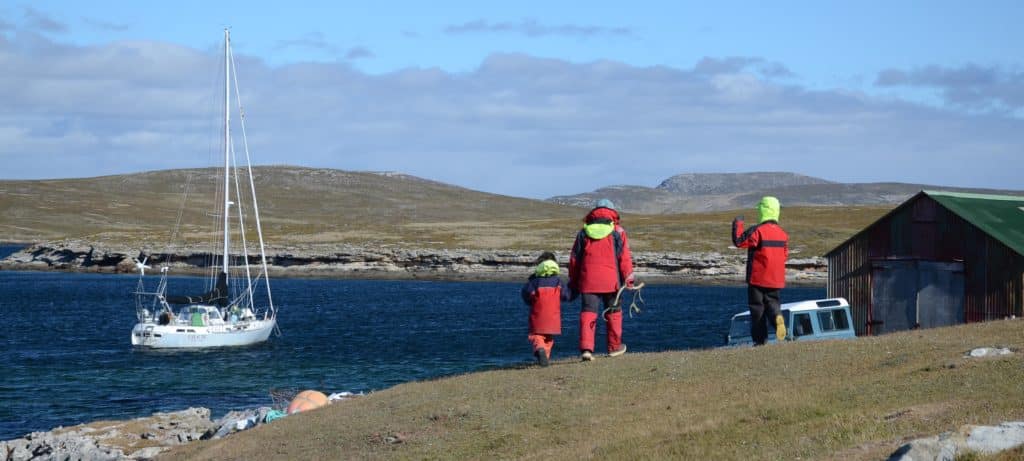
The weather comes through this anchorage in waves. First it’s a scene of summer idyll, the water and sky purest blue. Then dark clouds gather, making us wonder if there will be another hailstorm. The wind pauses here for an hour, or half a day, and then it comes again, screaming and running from the west.
The two islands protecting this spot are covered in low heath. Even in December, the middle of Southern Hemisphere summer, the vegetation is strangely the colors of Christmas — blood red and conifer green. No trees grow anywhere. There are sheep ashore, and cattle that run at the sight of us, and penguins that bray like donkeys.
My wife, Alisa, motions at the scene around Galactic, our 45-foot cutter — the thick beds of kelp, the elephant seals fighting on the beach with their weird moans and growls that carry so far. “Where are we?” she asks, with a kind of helpless amazement.
Alisa knows where we are literally, of course. We’re anchored between Barren and George islands, on the south side of the Falkland Islands. She’s referring to how unbridgeably different this place is from anywhere else we’ve been. And I understand just what she means. This kelp-infested, windy, lonely anchorage does a good impression of the end of the world.
We’ve been stuck here for days, waiting for the westerly wind to die. There are no other people around. And we — Alisa and I, and our sons Elias, 9, and Eric, 5 — are as happy as we can be. Before this visit, the Falklands were just another place that was indistinct on my mental map of the world, vaguely remembered from the war between England and Argentina in the 1980s and inconveniently located for a visit by sailboat. But now that we’re here, we’re discovering that the Falklands are a place from an earlier era, when the cruising scene was smaller, sailors visiting new places had the chance to discover them on their own and locals saw the arrival of a cruising boat as an event worth noting.
RELATED: Penguins in the Falklands
When we first arrived at Stanley, the capital and only town of any real size in the Falklands, we rafted up to three other sailboats tied to the working dock. These were all charter boats, mostly carrying passengers from the Falklands to Antarctica or South Georgia. The Falklands have long been an afterthought for visiting sailboats — a place to stop after rounding Cape Horn, or a launching-off place for the far south. Few boats have time, in the short southern summer, to explore the Falklands themselves.
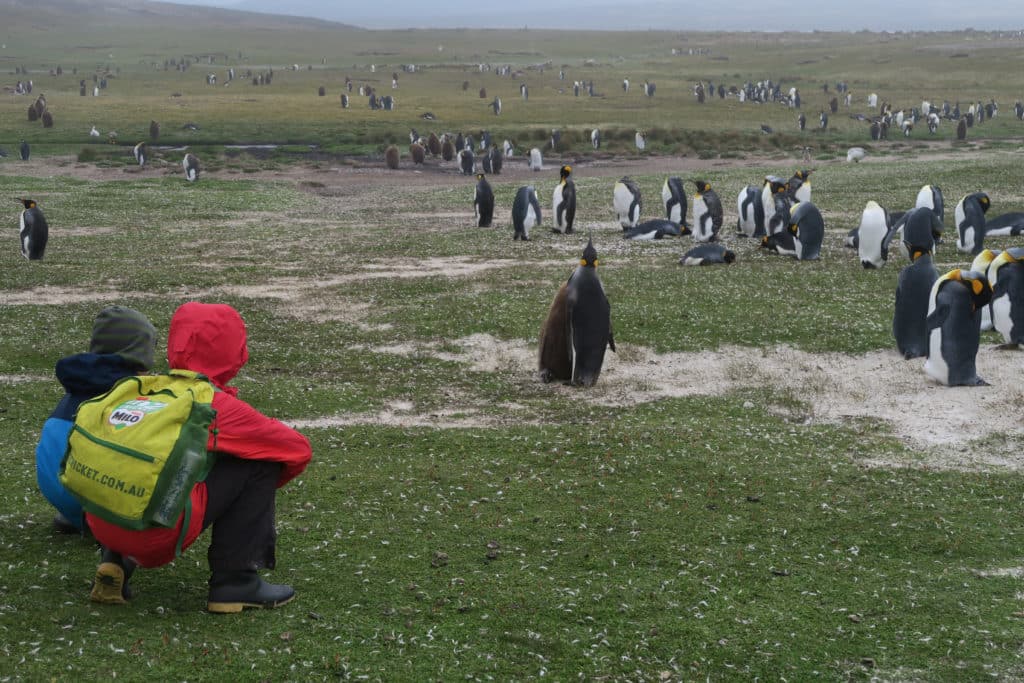
But when Galactic set out from Stanley, we had the month of December in hand to do nothing more than sail around the Falklands. We left on a day when the wind was absent, and we took the chance to make easy miles to the west with the motor, traveling along a flat and featureless coastline. Looking at the chart that day gave me ample opportunity to consider one of the great challenges of Falklands sailing: the legendary kelp. The chart indicated thick beds of kelp extending from every shore in a profusion that seemed like some kind of a joke. A closer look at some of the bays made me wonder where we would even sail, the open water appearing to be so scarce.
But as is the case with so many challenges of the sailing life, the kelp turned out to be more trouble in the anticipation than in the actual event. Kelp floats, after all, and so is easy to avoid. Better, kelp grows from rocks, so submerged dangers in the Falklands are helpfully marked by fronds of kelp. As we approached our first anchorage of the trip I began thinking of the kelp beds as a shadow shoreline that was more important to navigation than the actual land, and everything went fine.
The other thing for sailors to get used to in the Falklands is the wind. Twenty-five knots of wind just seems like more in the Falklands than it does in other places. And the wind often doesn’t satisfy itself with only blowing 25. Even after the year we had just spent in Patagonia, the gale that visited our first Falklands anchorage was an impressive thing. The muddy water of the inlet foamed and slapped around us. Galactic swung side to side and heeled over in the gusts. Not for the last time in the Falklands, we were quite happy with our large anchor.
That first blow lasted only for a day. But after we reached George and Barren islands, the westerlies set in as a part of those waves of weather that contributed to the end-of-the-world impression. A half day of fine weather would inevitably be followed by another blast of wind — wind that accelerated down the leeward slope of the Andes to rampage across the sea to the Falklands.
We were stuck in that anchorage for a week. These were the Furious 50s of southern latitudes, after all, and we weren’t surprised at persistent strong westerlies. Nor were we tempted to cross Falkland Sound, between East and West Falkland islands, until the west wind stopped blowing. Our determination to wait out the weather was helped by the fact that three of Galactic’s lower shrouds had broken strands, courtesy of our time in Patagonia and what was, in retrospect, undersize rigging. We had backed up the failing wire with a jury rig to keep the mast in place until we could return to Stanley to claim the replacement rigging that was coming from England on a ship.
We didn’t see another soul for the week that we waited, and that solitude made the remarkable natural history of the place seem like a gift that had been given to our family alone. Sea lions took every appearance of our dinghy as an invitation to play and would come charging out from the beach to see which of them could get closest to us. We watched elephant seals mock fight on the beach from only 30 yards away. Long walks on Barren and George islands showed us Magellanic penguins braying from their burrows and oystercatchers trying to distract us from their nests. A Johnny rook, the famously mischievous hawk of the Falklands, swooped down and grabbed Alisa’s hat right from her head.
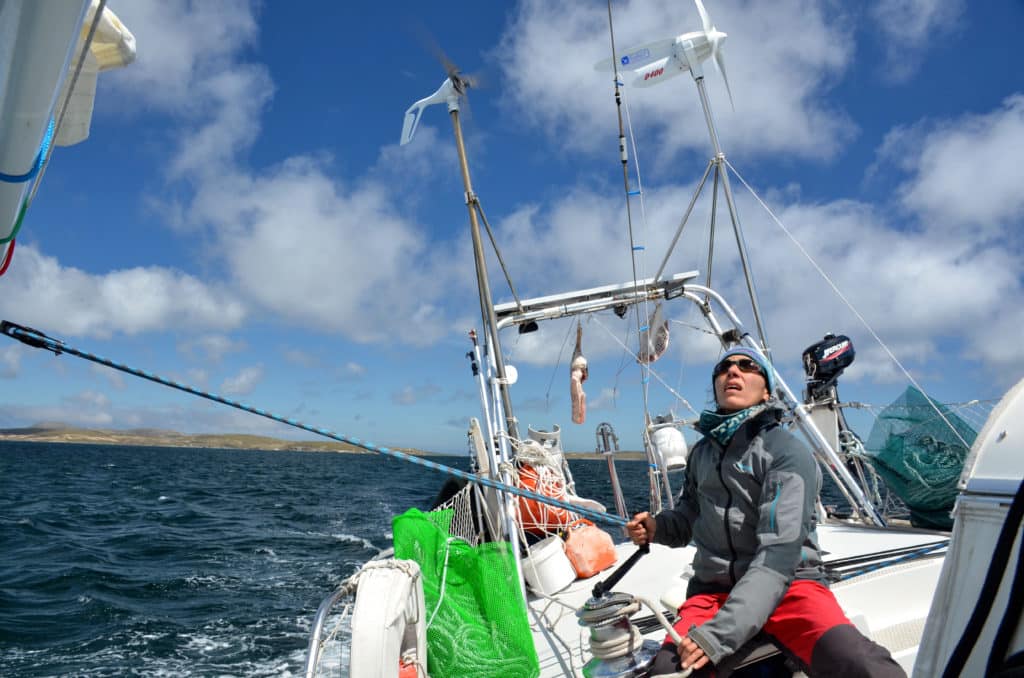
Visitors in the Falklands should request permission before going ashore on remote properties, and we had been in email contact with the May family, the owners of the wonderful islands we were rambling around. When we shifted to Speedwell Island, their home island, we caught up with the Mays and had our first experience of out-island hospitality. We anchored off the Speedwell settlement and went ashore to say hello, and found ourselves suddenly in their comfortable house, having tea with the extended family. The only tension, or comedy, in the moment came with the sartorial transition from high-latitude cruising to sipping tea in a stranger’s kitchen. Alisa apologized for her outfit as she pulled off her boots and rain gear and found herself having tea in her rainbow-striped long underwear — warm and comfortable, no doubt, but not quite the get-up for introducing yourself.
When the weather turned good, it turned good with a vengeance. A flat-calm day saw Galactic motoring across Falkland Sound to Albemarle, the 40,000-acre farm run by the Mays’ son. Here we were again met with spontaneous generosity and good company. Unfortunately, we couldn’t stay, as the Falklands is no place to waste a fair wind. A day of brilliant sailing took us around the southern corner of West Falkland Island, where increasingly dramatic sea cliffs shone improbably in the sun. To the boys’ delight, gentoo penguins porpoised next to Galactic, and leaping Peale’s dolphins guided us into our anchorage.
The next morning, as we were charging out of the anchorage with a reefed main, we heard a familiar voice hailing us on the VHF. It was our friend Leiv Poncet on Peregrine, his rugged 37-foot cutter, returning to his home on Beaver Island after a charter trip taking biologists to an albatross colony. Leiv was our reason for visiting the Falklands, and his home on Beaver Island, at the far western edge of the group, had been a much-wondered-about destination of ours for years. It was a treat to sail to Beaver in company with Leiv, and a rare treat indeed — he later told us that it was the first time he could remember coming across another sailboat outside of Stanley.
While Leiv dropped his passengers at nearby New Island, we went ashore on Beaver to look around. From a rocky hilltop above the settlement, we had a clear view of the fascinating landscape of the far western Falklands. Moor-covered hills were interspersed with interlocking waterways of the clearest blue. Straight below us were the scattered buildings of the settlement, deeply weathered wooden structures out of another era. Hauled up above the high-tide line was the equally weathered Damien II, the famous 50-footer that Leiv’s parents, Jérôme and Sally, used to pioneer Antarctic cruising. A few sheep scampered in the foreground. And over the entire scene … there was silence. There were no boats traveling in the channels, and no roads on the outer islands. There was no evidence of human activity beyond the settlement below our feet. Our family of traveling Alaskans felt instantly at home.
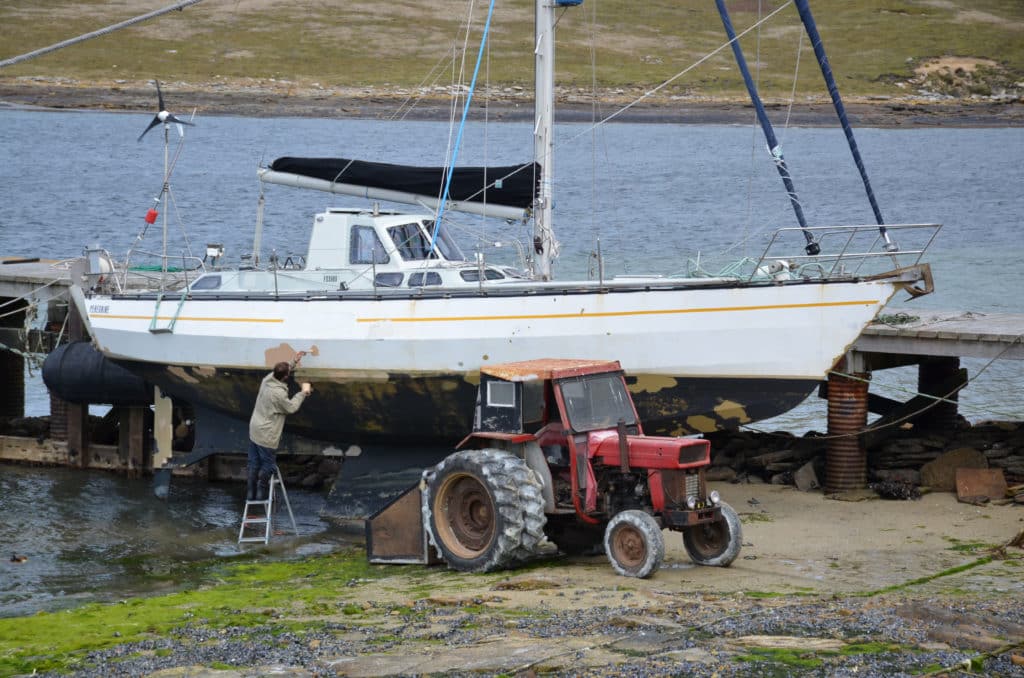
We had met Leiv during a winter Galactic and Peregrine spent in Tasmania. Over shared dinners we heard stories about his home on Beaver Island and the singlehanded Southern Ocean voyage that had brought him to Tasmania. Leiv reminded us of our favorite commercial fishermen in Alaska — people who are hugely competent on the water, and don’t feel any need to show off about it. Leiv was clearly someone to listen to when the subject was sailing in the global south, and he was an eminently likable guy. We hit it off.
When spring came, Leiv set off for home — a nonstop passage from New Zealand to the Falklands via Cape Horn. His parting words stayed with me, a spell of an invitation from one sailor to another. “Come to Beaver Island,” he said. “I’ll give you all the mutton and reindeer that you can eat. You can dry out alongside our jetty to work on Galactic, and I’ve got an old Perkins 4108 that you can raid for spare parts.” Later that spring we left too, and began to follow Leiv, very slowly. It turns out that there are a lot of places between Tasmania and the Falklands where it’s worthwhile to linger. When we finally reached the Falklands, it had been almost three years since we’d seen Leiv.
Leiv turned out to be a man of his word. The tone for our visit to Beaver was set on the first day, when Leiv casually asked our boys if we should go out and shoot a reindeer. The island is home to a herd descended from animals that Norwegian whalers introduced to South Georgia Island.
The boys were delighted to find themselves in the back of a Land Rover, driving on off-road tracks and looking for reindeer. Galactic has been to any number of places where the boys have been told that they shouldn’t touch this or disturb that. Beaver Island is a working farm — unique in that its income comes both from sheep and from charter sailboats, Damien II and Jérôme’s more recent Golden Fleece. It was a revelation to our boys. After living their whole lives on a sailboat, all their romantic notions of land life were being confirmed.
That evening on the beach, Leiv grilled us all the mutton chops we could eat. He showed Eric and Elias how to catch and cook minnows from the settlement creek, and how to pluck the geese that we ate for Christmas dinner. He taught the boys to harvest the succulent hearts of the tussac grass that grew on the island, and he took them to catch mullet for the smoke house.
Alisa set up shop in the settlement kitchen, and she and Leiv started canning jar after jar of mutton and reindeer to see Peregrine and Galactic through the long sea miles ahead. While Galactic would soon be off for South Georgia and South Africa, Leiv would be setting off on an epic solo adventure to our home waters in Alaska.
Leiv had delivered on his first promise, and he soon delivered on the other two. We’d been losing a battle with a troublesome holding tank on Galactic, and it was time for it to come out. I hoped I could make the job less noisome if the boat was out of the water. So on the day after Christmas, Galactic duly tied up on the jetty to go dry on the tide. As a measure of just how important scrounging and recycling are when you’re maintaining boats in an out-of-the-way place, consider that Leiv gave every indication of being happy to put our used holding tank on the Beaver Island scrap heap against the day when it might come in handy. In exchange, he pulled out his old Perkins, the victim of a fire on Peregrine, and soon valuable bits of the engine were tucked away on Galactic.
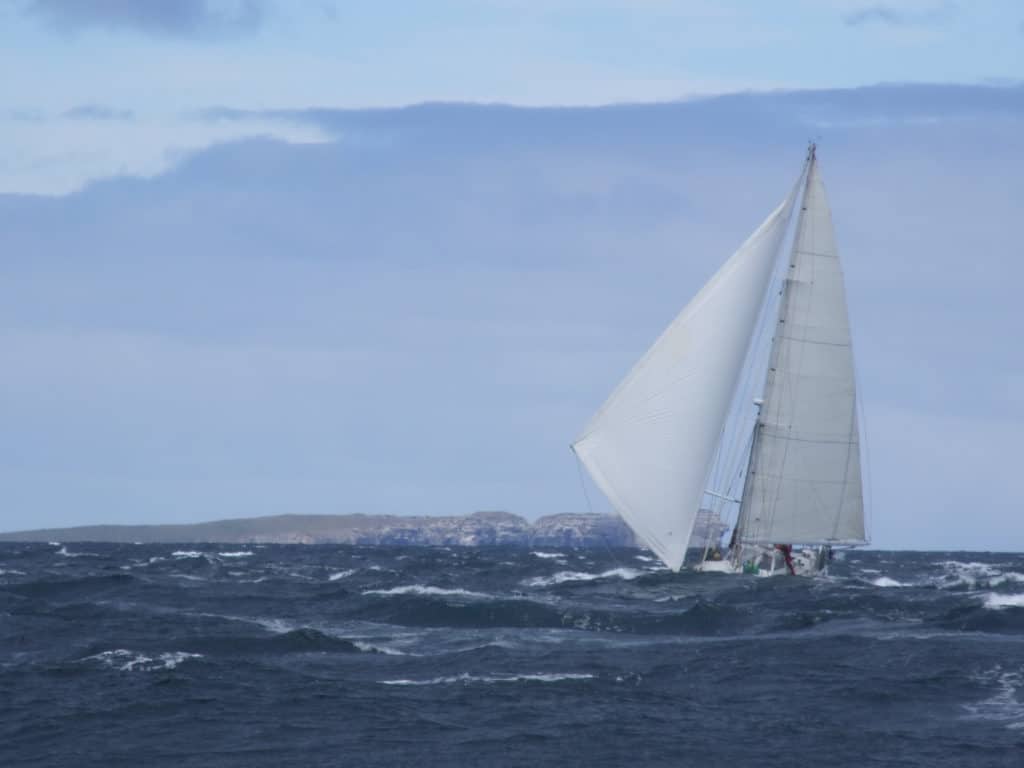
The time came for us to continue our circumnavigation of the archipelago. The southern summer would only be so long, and we had plans for the rest of it. We’ve left plenty of islands with a bunch of bananas hanging from the stern arch, but this was the first time we’d ever left an island with a leg of mutton hanging from the rigging — a parting gift from Leiv. And we came away with a more memorable gift. One of the great joys of our life on Galactic is the remarkable people whom we’ve been lucky enough to call our friends; the great downside is the way our constant motion means we’ll likely never see most of them again. Our visit to Beaver Island was a chance to reconnect with a sailing friend on his remarkable home turf. In the midst of the wandering that would soon see Peregrine and Galactic on opposite sides of the Earth, we had each come to rest at the same time, in a splendid corner of the world, to catch up with each other’s news. That was a highlight of our sailing lives.
Of course, there was plenty more to discover during the rest of our sail around the Falklands. There was the sailing itself, which, in spite of our parted shrouds, gave us many days of delight and easy travel. There was the fantastic wildlife. We had other elephant seal haulouts to discover, and albatross and penguin colonies where our family could sit just a few yards from an incredible concentration of avian life to watch the show. And there was the way that the islands seemed to glow on a midsummer day, in the heartbreaking colors of the unpolluted far south.
But, for all the physical delights of the place, it was the people who made the Falklands. There was the hospitality of Leiv, who took the time at the busy peak of summer to show us around his island, and who always had a patient answer for our boys’ endless questions. There was the May family, inhabitants of remote farms who made visiting strangers instantly welcome. But even on the busier islands that play host to cruise-ship passengers, we found that it was impossible to go ashore without sitting down for tea and cookies, and in the relative bustle of Stanley we found more kindness than I could relate here. People are the soul of cruising, just like they’re the soul of any travel. Is it any wonder that we left the Falklands thinking we’d found the best cruising in the world?
– – –
At press time the Litzows were back in their home port of Kodiak, Alaska, after completing a 10-year, 65,000-mile voyage. Get in touch with Mike and his family at thelifegalactic.blogspot.com.







